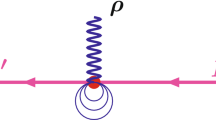Abstract
For a transition between states with different total angular momentum values, we develop a method for constructing an electromagnetic current operator that satisfies the Lorentz-covariance and current-conservation conditions. Our method is realized in the framework of an instant form of relativistic quantum mechanics using the general method of relativistic parameterization of matrix elements of local operators. We illustrate the method by calculating the radiation decay of a ρ-meson into a pion. In the modified impulse approximation, we obtain an analytic expression for the transition form factor of this process in the form of an integral representation of dispersion type. Results of the numerical calculation agree with the results of calculating the light-front dynamics and with the model of vector meson dominance.
Similar content being viewed by others
References
P. A. M. Dirac, Rev. Modern Phys., 21, 392–399 (1949).
H. Leutwyler and J. Stern, Ann. Phys., 112, 94–164 (1978).
B. D. Keister and W. N. Polyzou, “Relativistic Hamiltonian dynamics in nuclear and particle physics,” in: Advances in Nuclear Physics (J. W. Negele and E. W. Vogt, eds.), Vol. 20, Plenum, New York (1991), pp. 225–479.
F. Coester, Progr. Part. Nucl. Phys., 29, 1–32 (1992).
E. Gilman and F. Gross, J. Phys. G, 28, R37–R116 (2002); arXiv:nucl-th/0111015v1 (2001).
A. F. Krutov and V. E. Troitsky, Phys. Part. Nucl., 40, 136–161 (2009).
W. N. Polyzou, Ch. Elster, W. Glöckle, J. Golak, Y. Huang, H. Kamada, R. Skibiński, and H. Wita-la, Few-Body Systems, 49, 129–147 (2011).
W. N. Polyzou, Ann. Phys., 193, 367–418 (1989).
B. Bakamjian and L. H. Thomas, Phys. Rev., 92, 1300–1310 (1953).
W. N. Polyzou, Phys. Rev. C, 82, 064001 (2010); arXiv:1008.5222v1 [math-ph] (2010).
E. P. Biernat and W. Schweiger, Phys. Rev. C, 89, 055205 (2014).
M. Gómes-Rocha, Phys. Rev. D, 90, 076003 (2014); arXiv:1409.5239v1 [hep-ph] (2014).
A. F. Krutov and V. E. Troitsky, Theor. Math. Phys., 143, 704–719 (2005).
A. F. Krutov and V. E. Troitsky, Phys. Rev. C, 65, 045501 (2002); arXiv:hep-ph/0101327v1 (2001).
A. F. Krutov and V. E. Troitsky, Phys. Rev. C, 68, 018501 (2003); arXiv:hep-ph/0210046v1 (2002).
V. E. Troitsky and Yu. M. Shirokov, Theor. Math. Phys., 1, 164–170 (1969).
V. V. Anisovich, M. N. Kobrinsky, D. I. Melikhov, and A. V. Sarantsev, Nucl. Phys. A, 544, 747–792 (1992).
E. V. Balandina, A. F. Krutov, and V. E. Troitsky, Theor. Math. Phys., 103, 381–389 (1995).
E. V. Balandina, A. F. Krutov, and V. E. Troitsky, J. Phys. G, 22, 1585–1592 (1996).
A. F. Krutov and V. E. Troitsky, JHEP, 9910, 028 (1999).
A. F. Krutov and V. E. Troitsky, Eur. Phys. J. C, 20, 71–76 (2001).
A. F. Krutov and V. E. Troitsky, Theor. Math. Phys., 116, 907–913 (1998).
A. F. Krutov, M. A. Nefedov, and V. E. Troitsky, Theor. Math. Phys., 174, 331–342 (2013).
A. F. Krutov, V. E. Troitsky, and N. A. Tsirova, Phys. Rev. C, 80, 055210 (2009); arXiv:0910.3604v2 [nucl-th] (2009).
S. V. Troitsky and V. E. Troitsky, Phys. Rev. D, 88, 093005 (2013); 91, 033008 (2015); arXiv:1501.02712v2 [hep-ph] (2015).
A. A. Cheshkov and Yu. M. Shirokov, Soviet Phys. JETP, 17, 1333–1339 (1963).
V. P. Kozhevnikov, V. E. Troitsky, S. V. Trubnikov, and Yu. M. Shirokov, Theor. Math. Phys., 10, 30–37 (1972).
A. R. Edmonds, “Angular momentum in quantum mechanics,” Preprint No. CERN-55-26, CERN, Geneva (1955).
F. Cardarelli, I. L. Grach, I. M. Narodetskii, G. Salmé, and S. Simula, Phys. Lett. B, 359, 1–7 (1995); arXiv: nucl-th/9509004v2 (1995).
J. Yu, B.-W. Xiao, and B.-Q. Ma, J. Phys. G, 34, 1845–1860 (2007); arXiv:0706.2018v1 [hep-ph] (2007).
U. Vogl, M. Lutz, S. Klimt, and W. Weise, Nucl. Phys. A, 516, 469–495 (1990)
B. Povh and J. Hüfner, Phys. Lett. B, 245, 653–657 (1990)
S. M. Troshin and N. E. Tyurin, Phys. Rev. D, 49, 4427–4433 (1994).
S. B. Gerasimov, Phys. Lett. B, 357, 666–670 (1995); “Electromagnetic moments of hadrons and quarks in a hybrid model,” Preprint No. E2-89-837, Joint Inst. Nucl. Res., Dubna (1989).
Author information
Authors and Affiliations
Corresponding author
Additional information
Translated from Teoreticheskaya i Matematicheskaya Fizika, Vol. 184, No. 2, pp. 290–306, August, 2015.
Rights and permissions
About this article
Cite this article
Krutov, A.F., Polezhaev, R.G. & Troitsky, V.E. Describing radiation decay using the instant form of relativistic quantum mechanics. Theor Math Phys 184, 1148–1162 (2015). https://doi.org/10.1007/s11232-015-0323-x
Received:
Revised:
Published:
Issue Date:
DOI: https://doi.org/10.1007/s11232-015-0323-x



